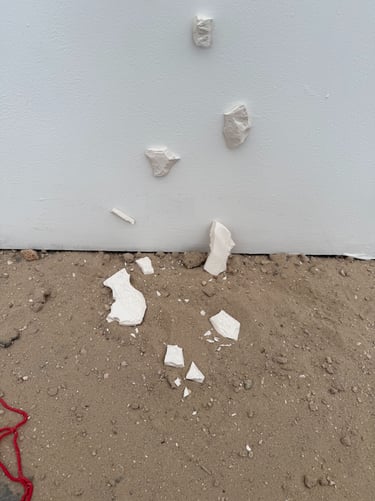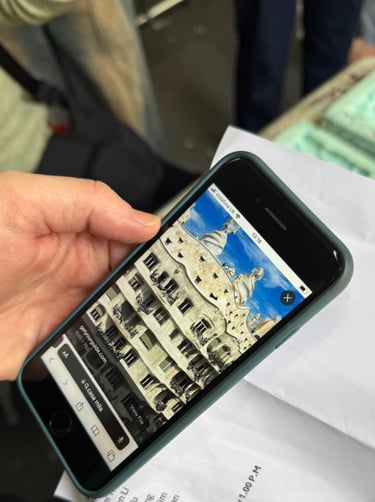Between Drawing and Space
Gavin noticed a clear movement from drawing into sculpture in the MA show. A thin red line delineated a field of sand from the floor and the installation then moved into forms and ground. This aligns with writing on expanded drawing where line leaves the page and operates as a spatial condition organised by field, seam and spacing (Krauss 1979). I recognise this path. Photographs of foam outlines became simple line drawings made as continuous rhythms. The drawings trained the hand rather than planned outcomes. That learned rhythm informed carve, pour and placement.
Drawing never left; it changed form. A seam between plates is a drawing in space. A narrow gap is a line the body reads while walking. In a new series titled What the Water Keeps, field drawings sit with ceramic fragments so that line and shard complete each other. The drawn current finds its edge in matter, and the fragment reads as a held gesture rather than a loss. Working on paper with fragments confirmed that spacing does the real work here. A small pause between mark and shard becomes the seam the eye follows. Precedents that help frame this shift include early room works by Eva Hesse, where line is literalised in space and material fragility is kept active (Temkin 2002), and reflections on drawing with water as a way to register change over time rather than depict it (Kovats 2014).




Tutorials with Sarah later compared my wave reliefs to Casa Milà (La Pedrera) by Antoni Gaudí, noting how its interior spaces and curved walls behave like a slow current moving through stone. The comparison extended beyond the surface resemblance to water. It pointed to how the building’s interior transitions, light wells and continuous lines create a rhythm that can be read spatially, much like the seams and joins in my ceramic fields. The undulating façade itself mirrors the flow of waves, its rippling balconies and textured surfaces echoing how movement is held in still form. This connection shifted my attention from individual reliefs to an architectural sense of continuity, where each fragment contributes to a larger, breathing field.
The field is also where fragments find their place. A shard set in the right company becomes legible as time rather than as failure. Under raking light the seam reads before the object; the viewer first follows distance, then mass. The discipline that once lived in a grid of panels returns as measured distance in a field of reliefs. Tone shifts, height shifts and narrow seams act as lines the body reads while moving, extending the spatial rhythm first explored through architectural comparison. This alignment between material placement and movement echoes Tim Ingold’s account of line as a living trajectory rather than a fixed mark (2007). Rhythm becomes the quiet structure through which the work is experienced.


Next - Display as method
Works cited
Gaudí, A. (1912–1915) Casa Milà (La Pedrera). Barcelona: Fundació Catalunya La Pedrera. Available at: https://www.lapedrera.com/en/
Ingold, T. (2007) Lines: A Brief History. London: Routledge.
Kovats, T. (2014) Drawing Water: Drawing as a way of thinking. London: Hayward Publishing.
Krauss, R. (1979) ‘Sculpture in the Expanded Field’, October, 8 (Spring), pp. 30–44.
Temkin, A. (2002) Eva Hesse: Catalogue Raisonné. New Haven: Yale University Press.